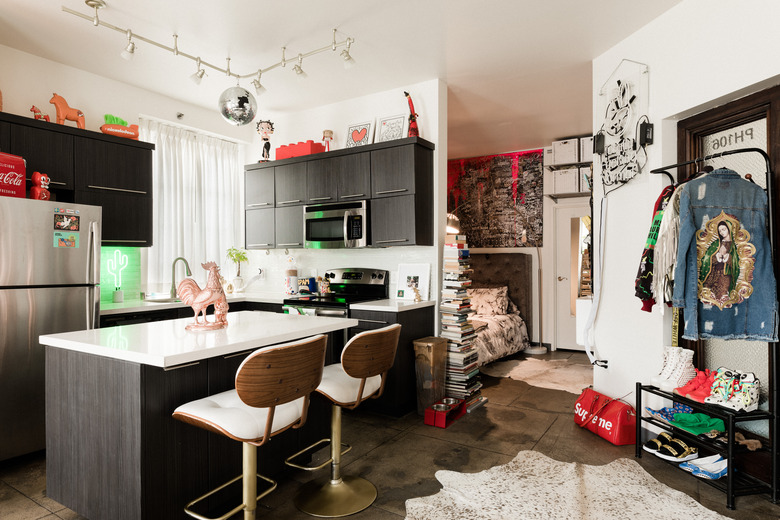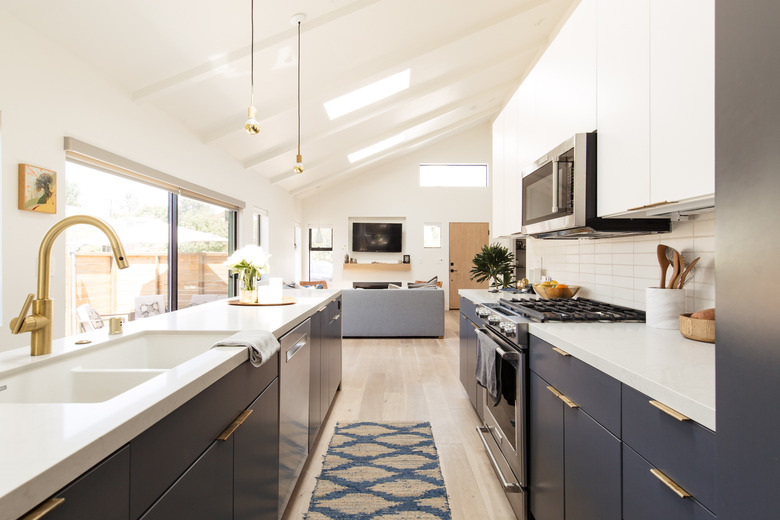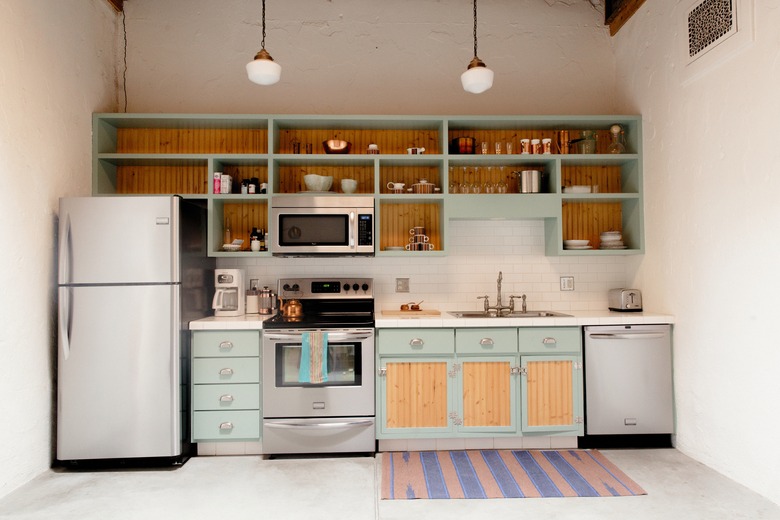How To Choose A Built-In Microwave
The microwave oven may be the most used appliance in many kitchens. In addition to being able to perform a number of tasks, such as cooking, defrosting, reheating and, in some cases, broiling, microwave ovens are relatively safe and are often the first cooking appliance that parents let their older children use. They are the go-to appliance when food needs to be heated quickly.
Microwave ovens heat and defrost much quicker than conventional ovens because they use electromagnetic waves to heat the food directly. The heat energy goes right to the target — in this case, the food inside the microwave oven. A conventional oven heats the entire oven cavity. A waveguide on the side walls of the microwave directs the energy wave to the food. In most microwave ovens, the revolving turntable aids in more even heating.
Built-in microwave models free up counter space, and some models can contribute to a sleek, streamlined look. But there are things to consider when you want to install one, such as the size of the unit, the type of built-in, venting and special installation requirements.
Microwave Oven Basics
Microwave Oven Basics
When first introduced, microwave ovens were all countertop models. All that was necessary to get them up and running was to clear a space on the counter and then plug them in. That was also their drawback: They took up valuable countertop space. A large countertop unit can be 22 to 24 inches wide, 10 to 12 inches high and 19 or 20 inches deep. As with most appliances, the microwave sits unused most of the time.
You have to read the manufacturer's literature to get the overall dimensions of most microwave ovens. That's because they are usually sized by the cubic foot to reflect how much space the interior provides. A small appliance might be something like 0.5 or 0.8 cubic feet. A large microwave can be 2+ cubic feet.
Another way to separate products is in the power they consume in watts to operate. The range is from about 600 watts to 1,200 watts. The higher the wattage, the quicker the cooking. Wattage is also associated with physical size. Larger units are usually more powerful.
Types of Built-In Microwave Ovens
Types of Built-In Microwave Ovens
In order to free up valuable countertop space, manufacturers developed products that could be placed in an out-of-the-way location. These appliances are called "built-in microwaves," but the term covers a variety of product types.
Depending on the manufacturer, a built-in microwave can mean an appliance installed over a range or cooktop (either as a set or added later), a microwave installed in a cabinet or a cabinet shelf, a microwave that is part of a microwave/wall-oven combination or a microwave drawer. Each gets the appliance off the countertop but in different ways.
A microwave oven installed over the cooking range creates a compact cook zone without using countertop space. These units are sized to fit in the space above the range. In general, the top of the microwave oven can be no more than 66 inches from the floor. As with all microwave ovens, the price depends on the size and features, but prices range from about $150 to over $900. These products may require professional installation.
Over-the-Range Microwave Installation
Over-the-Range Microwave Installation
These products are designed specifically for over-the-range installation and include a built-in ventilation system. In a typical installation, the microwave oven is installed under a short wall cabinet. The grounded electrical outlet for the microwave should be in the cabinet, so an installation may involve running power to the cabinet. The product will contain a mounting bracket and templates to attach the unit to the wall and to the underside of the cabinet.
Most building codes require some sort of mechanical ventilation over a cooktop, and over-the-range microwaves are equipped to provide that ventilation, but not all microwaves do it in the same way. With the purchase of an extra ventilation kit, some microwaves can be installed so that they vent to the outside, which requires running ductwork from the appliance through the back wall or up through a cabinet to the outdoor vent. A position paper from the Home Ventilating Institute lays out recommended fan power.
Others draw room air into its filter and then recirculate the air back into the room. Routine maintenance involves cleaning filters and grease traps regularly. Most manufacturers do not recommend this type of installation over professional-style cooking appliances because the exhaust fans are usually not strong enough to provide adequate ventilation.
Some kitchen designers try to avoid this type of installation. The microwave is too high for some people to use comfortably, and it is necessary to lean over the cooktop to operate the microwave. Some people are forced to reach up and remove hot items from the microwave, which could be dangerous.
Shelf and Cabinet Built-In Microwaves
Shelf and Cabinet Built-In Microwaves
Some microwaves can be placed on a shelf that hangs from a wall cabinet. There are wall cabinets with this built-in shelf available. As long as there is a grounded electrical outlet nearby and 2 or 3 inches of free space around the unit for ventilation, the installation gets the appliance off the countertop. The ventilation in this case is for steam from the oven that can be generated during cooking.
Others are designed to be attached to the underside of a wall cabinet, much like over-the-range units. The manufacturer will provide a mounting bracket and fasteners for attaching the appliance to the cabinet bottom. You may need to run electrical power to the cabinet. These units do not have built-in ventilation systems.
Many people consider a true built-in microwave to be one that is installed within a run of cabinets, either below the countertop or among the wall cabinets. These products are designed to fit within standard doorless cabinets. Many manufacturers offer trim kits so that the transition between microwave and cabinetry is seamless. The ovens have either pull-down or swing-out doors.
Some of these products can cost over $2,000, but they are usually the latest designs and feature the most advanced technology, such as convection heating and units that can sense the needed cooking temperature. Convection technology uses fans to help circulate the heat.
Built-In Microwave Drawers
Built-In Microwave Drawers
While manufacturers tweaked countertop models for most built-in installations, microwave drawers represent a more drastic change in the products. Outwardly, they differ from other microwaves in that the oven cavity slides out like a drawer. Some drawers are automatic. Simply touch the handle, and the drawer slides open; touch it again, and it closes. The ovens are designed to be installed in base cabinets.
The drawers offer some functional benefits. For one, lifting hot items up from the drawer is safer, and for some people, it's easier than reaching up and pulling items out of the oven. It is also easier to place items in the oven because there is no need to crouch down. The automatic opening and closing function means you don't have to put down plates and cups to use the oven.
They are very sleek in appearance and can complement most kitchen designs. Most have stainless steel drawer fronts and trim. The face of the drawer can be 24 to 30 inches wide. Some have hidden controls for a clean appearance. Microwave drawers have child lock-out mechanisms.
There are some drawbacks to microwave drawers. None of them offer convection cooking technology, and because they slide on tracks, the energy source is located in the ceiling of the oven rather than on the sides like other microwaves. That means there is no turntable. On average, these products are among the most expensive of all microwaves. They start at about $1,000, with many in the $1,200 to $1,500 range.
Microwave Drawer Installation
Microwave Drawer Installation
The installation requirements for microwave drawers are similar to those of other units built into cabinetry. They can be placed in base cabinets or in cabinets designed for wall ovens. The area must allow for ventilation of the unit but still fit snugly. An electrician will need to install a grounded electrical outlet in one of the upper corners of the cabinet that will hold the drawer. The manufacturer's directions will specify the exact location.
Most instructions call for an anti-tipping block screwed to the upper part of the rear cabinet wall. This is usually a small piece of wood that, when the drawer is placed in position, will prevent the drawer from tipping when in use. Drawers are often placed over short base cabinets, which may not have a top. A section of 3/4-inch-thick plywood can serve as the base of the drawer area. The base must be able to support 100 to 150 pounds.
General Built-In Microwave Installation Tips
General Built-In Microwave Installation Tips
These built-in units fit relatively snug in the cabinets, but there should be a few inches of free space all around to allow for ventilation per the manufacturer's directions. In this case, the ventilation is from the unit, as steam may escape during cooking.
Many manufacturers stipulate where the electrical source should be located, usually in one of the upper rear corners. Some units have mounting fins for screwing the oven to the edge of the cabinet. It is also important to pay attention to weight requirements. Manufacturers require the ability of the floor of the microwave cabinet to support 100 to 150 pounds.
Another trend that occurs at the upper end of the market is combining wall ovens with microwaves. Usually, the smaller microwave is installed over the conventional oven. The combination makes for a very sleek design because the handles, trim and door windows all match. The oven may be 27 or 30 inches wide, but the microwave will be smaller and more in line with standard microwave sizes. However, the trim makes them seem the same size.
The requirements for built-in cabinet installation apply to microwave/wall-oven combinations, although most require that the bottom of the microwave unit be raised above the cabinet floor by a few inches to allow for the venting of heat from below. Manufacturers usually supply mounting tracks that are attached to the bottom of the unit. Cabinet weight capacity is the same as the requirements for built-in microwaves.
Built-In Microwave Maintenance
Built-In Microwave Maintenance
For the most part, cleaning a built-in microwave is the same as keeping a countertop model clean. Follow the manufacturer's cleaning instructions, which usually advise wiping down the front of the oven using a mild detergent and a soft cloth. Don't use harsh chemicals or abrasives of any kind. There are cleaners designed for stainless steel surfaces. Apply the cleaner and buff in the direction of the stainless steel grain.
For the inside, use a mild detergent. Some manufacturers recommend heating water in a microwave-safe cup to produce steam that can soften tough stains. Remove the turntable for cleaning with dishwashing detergent and dry thoroughly before placing it back in the oven. There are recipes for getting rid of odors, such as heating lemon juice or vinegar for a few minutes in the microwave oven.
When cleaning a microwave drawer, be sure to lock the drawer in the open position. Clean it as you would any other microwave and remove crumbs and other particles from the drawer tracks to keep them operating smoothly. Follow the manufacturer's directions for cleaning the waveguide area. In drawers, it is located at the top of the unit.


